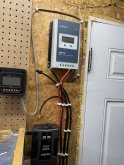This solar system is mainly for some LED lights •x10 LED light bars 20W, Input voltage:85-265V, 50/60HZ, Efficiency:110-120lm/w
My system includes the following:
•12V,65Ah, Deep cycle battery (using the lights maybe 3 hours per day.)
•800watt inverter.
•30 amp epever charge controller, with MT50 and temp sensor.
•60 amp breaker going to the inverter.
•20 amp breaker to the charge controller.
•20 amp breaker located outside acting as a rapid shut down.
•x1 100 watt renogy panel.
•40ft of 10AWG solar cable to panel.(coming out of 1/2” conduit in photo)
•All 8 AWG cable is 4 feet of jumper cable, properly crimped with ring terminals and heat shrink.
Is my inverter cable is alittle under gunned with a 60amp breaker? I was thinking 6 AWG since it’s over 3 feet? I’ll never be using the full potential of the controller, that’s why I kept the fuses at 20 amps.
Panel located on roof.
I was going to run 6AWG grounding wire(bare??) from the panel into an already existing ground rod beside my shop. Do I really have to run a separate ground rod 8 feet away?
Also can I ground my epever controller through an closed unused junction box beside my battery to ground my common ground system?
I realize none of this is up to code or doesn’t follow any NEC regulations. I just don’t want to burn my shed down.
Please let me know what info I forgot to mention and any discrepancies you see in the given photos. Thanks!



My system includes the following:
•12V,65Ah, Deep cycle battery (using the lights maybe 3 hours per day.)
•800watt inverter.
•30 amp epever charge controller, with MT50 and temp sensor.
•60 amp breaker going to the inverter.
•20 amp breaker to the charge controller.
•20 amp breaker located outside acting as a rapid shut down.
•x1 100 watt renogy panel.
•40ft of 10AWG solar cable to panel.(coming out of 1/2” conduit in photo)
•All 8 AWG cable is 4 feet of jumper cable, properly crimped with ring terminals and heat shrink.
Is my inverter cable is alittle under gunned with a 60amp breaker? I was thinking 6 AWG since it’s over 3 feet? I’ll never be using the full potential of the controller, that’s why I kept the fuses at 20 amps.
Panel located on roof.
I was going to run 6AWG grounding wire(bare??) from the panel into an already existing ground rod beside my shop. Do I really have to run a separate ground rod 8 feet away?
Also can I ground my epever controller through an closed unused junction box beside my battery to ground my common ground system?
I realize none of this is up to code or doesn’t follow any NEC regulations. I just don’t want to burn my shed down.
Please let me know what info I forgot to mention and any discrepancies you see in the given photos. Thanks!



Last edited:


